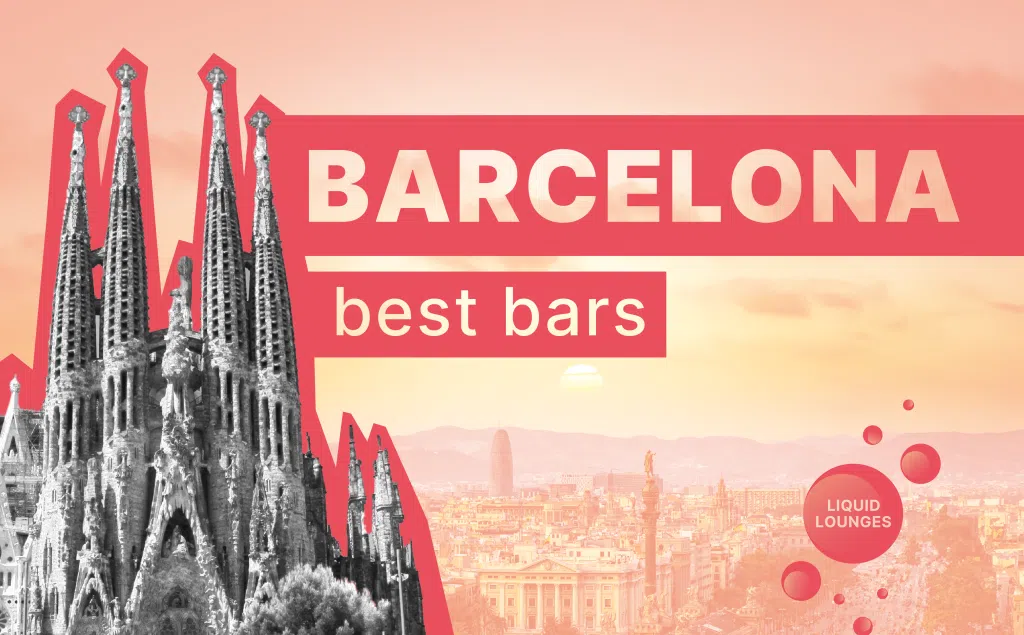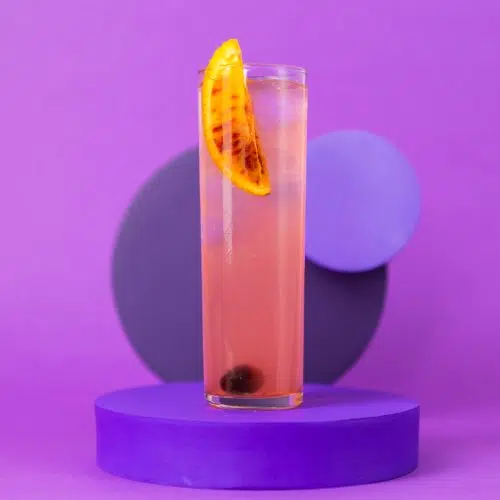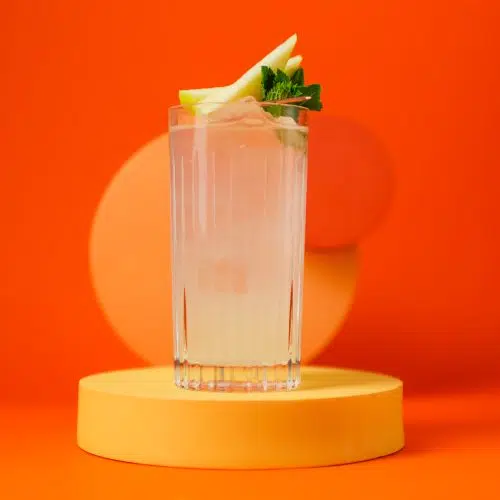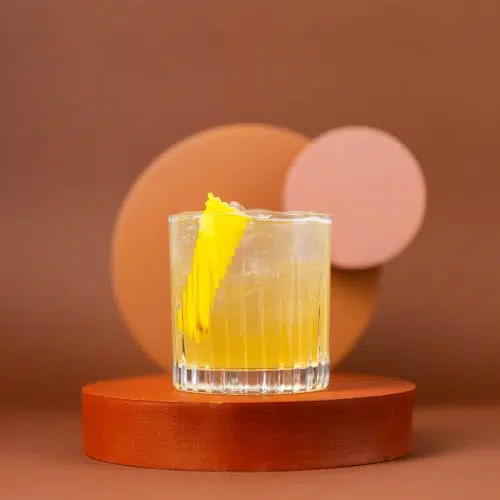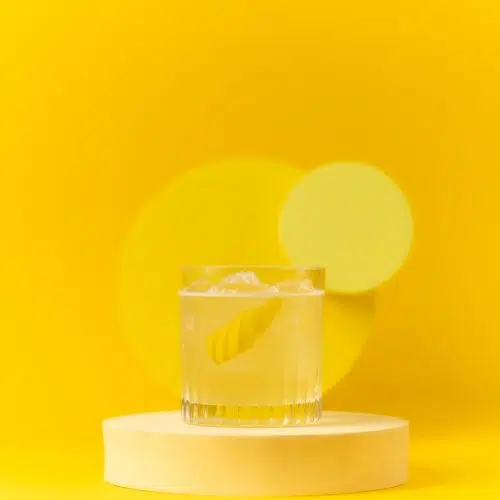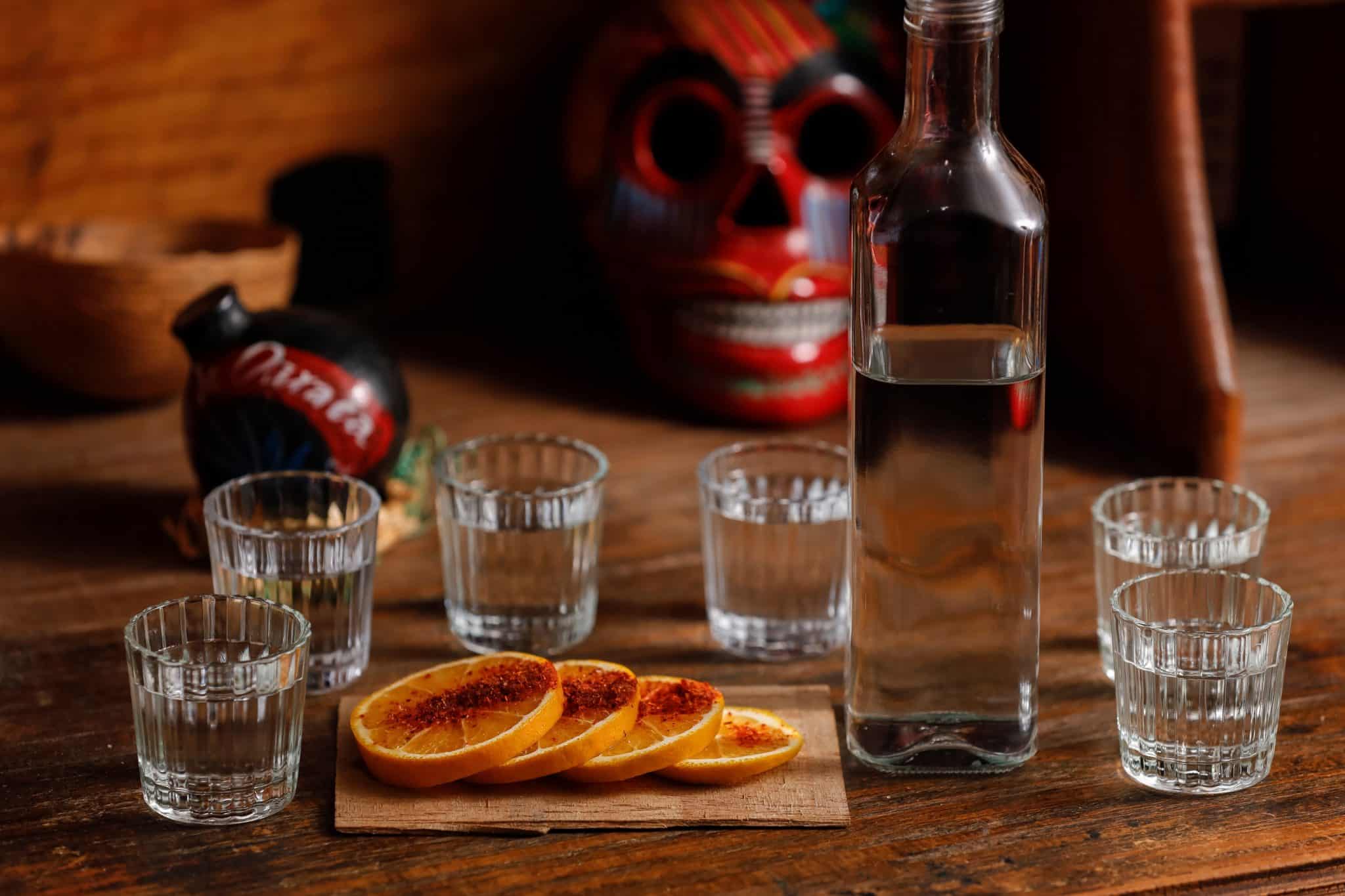Home / Mezcal
Mezcal
- Updated February 1, 2024

Mezcal Guide – What to Know Before You Shop Mezcal Online
There’s a famous saying in Mexico: “Para todo mal, mezcal, y para todo bien, también.” This translates to “For everything bad, mezcal, and everything good, the same.” Imagine a special drink people believe is perfect for life’s ups and downs. But did you know that while all tequilas are mezcals, the reverse isn’t true? You might have heard of the infamous worm, or “gusano,” that sometimes graces the bottom of a mezcal bottle. While many believe it’s a mark of authenticity, it’s more of a marketing gimmick. But it sure does add to the drink’s mystique! And while some swear by its hangover-free promise, remember to always relish in moderation.
What is Mezcal?
Mezcal is a distilled alcoholic beverage made from the fermented juice of agave plants, primarily produced in Mexico. Mezcal can be made from various types of agave and is known for its smoky flavor, which results from roasting the agave hearts in underground pits before fermentation.
The name “mezcal” comes from the Nahuatl words “metl” and “ixcalli”, which together mean “oven-cooked agave.” Nahuatl was the language of the Aztecs, and the term reflects the traditional method by roasting the agave hearts in underground pits.
Mezcal vs Tequila: the differences
All tequilas fall under the mezcal category as it refers to any liquor made from agave. However, not all mezcals qualify as tequilas due to the specific criteria Tequila must meet.
Both come from Mexico and are distilled from the agave plant. However, while Mezcal can be produced using over 30 different types of agave, Tequila is distilled explicitly from the blue agave plant.
Production Regions
Mezcal is mostly produced in the region of Oaxaca, but it’s also made in several other areas within Mexico. On the other hand, Tequila’s production centers around the city of Tequila in the state of Jalisco, with some production in neighboring states.
Production Process
The unique smoky flavor comes from the traditional method of roasting the agave hearts (piñas) in underground pits before fermentation. In contrast, Tequila’s production involves steaming the hearts in above-ground ovens, resulting in a different flavor profile.
Flavor Profile
Mezcal is known for its distinctive smoky taste, which can vary based on the type of agave used and the specific production techniques. Tequila has a cleaner and crisper taste, especially from 100% agave.
Why we like Mezcal
We love it for its smoky kick, especially from brands like Del Maguey, Ilegal, and Clase Azul. Each brand has a unique twist thanks to the old-school way it’s made. The different agave plants give us a world of flavors, from sweet to earthy. For us, Mezcal is more than a drink; it’s a piece of Mexico’s heart. We’re big fans of its handmade touch, making each sip feel special. And let’s not forget how awesome it is in cocktails! Our favorites include the smoky Oaxacan Old Fashioned and the refreshing Mezcal Mule.
Types of Mezcal
Three categories of mezcal are officially recognized by the Consejo Regulador del Mezcal (CRM):
Mezcal
This general category is flexilble in its production methods. The agave used for this type can be cooked in various ways, including masonry ovens or industrial autoclaves, essentially large pressure cookers. Once cooked, the agave is mashed using mechanical methods like mills or shredders. The distillation process for this category often employs column stills, known for their efficiency.
Mezcal Artesanal
Mezcal Artesanal bridges the gap between modern and traditional techniques. The agave for this type is cooked in either underground pits or above-ground masonry ovens. The mashing process leans toward tradition, with manual methods or animal-drawn tahonas (large stone wheels). Producers use clay pots or copper stills for distillation, adding to the drink’s authentic taste.
Mezcal Ancestral
This represents the pinnacle of tradition. Producers cook in earthen pits lined with stones, infusing the heart of the plant with earthy flavors. The mashing process remains manual, involving wooden mallets used in canoes or troughs. The distillation is carried out in clay pot stills.
More classifications can be made based on Agave variety and aging:
Espadín stands out due to its quicker maturation, making it a preferred choice for many producers. On the other hand, Tobalá, which grows wild in rocky terrains at high altitudes, imparts a sweet and fruity taste to the spirit. Tepeztate can mature up to 25 years, resulting in spirits with complex and layered flavors. Lastly, the larger Arroqueño is known for giving the spirit a rich and full-bodied taste.
Joven is a clear and unaged spirit, showcasing the raw and pure flavor. Reposado, aged in wooden barrels for up to a year, takes on a golden color and adds flavors from the wood. Añejo, aged for over a year, offers a deeper hue and a more intricate flavor profile, making it a favorite for those seeking a more mature taste.
What does Mezcal taste like?
Mezcal has a distinctive smoky flavor with underlying notes ranging from sweet, fruity, and floral to earthy, spicy, and woody. These depend on the type of agave used and the production method.
Espadín often delivers a balanced flavor with a touch of smokiness. In contrast, Tobalá leans towards a sweeter and fruitier palate, sometimes hinting at wildflowers. Tepeztate can introduce more complex and layered flavors to the spirit, often with herbal or vegetal undertones. Arroqueño emphasizes deeper earthy tones.
The aging process further refines and alters the taste. Joven provides a clear window into the agave’s natural flavor. As it ages and becomes Reposado, the spirit is influenced by the wooden barrels it’s stored in, often acquiring caramel or vanilla notes. Añejo, aged even longer, showcases a deeper and more intricate flavor profile. The long interaction with the wood makes its influence more pronounced, adding layers of richness and complexity to the spirit.
Top 10 Mezcal brands
Following list of Mezcal brands are our favorites:
Casamigos Mezcal
Casamigos, co-founded by George Clooney, Rande Gerber, and Mike Meldman, initially began as a tequila brand. Their venture into Mezcal offers a Joven (young) expression from 100% Espadín. The brand emphasizes its smoothness, with tasting notes often highlighting hints of tamarind, pomegranate, banana, and mango. The smokiness is present but kept subtle, making it approachable for those new to the spirit.
Dos Hombres
Dos Hombres is the brainchild of “Breaking Bad” co-stars Bryan Cranston and Aaron Paul. Their Mezcal, sourced from the Oaxaca region, is an artisanal Espadín Joven. The brand prides itself on its traditional production methods, which include cooking in earthen pits and using horse-drawn tahonas for mashing. Tasting notes often describe Dos Hombres as having a balanced profile with apple, mango, local fruits, wood, and smoke.
400 Conejos
400 Conejos, meaning “400 Rabbits,” is a brand rooted in Mexican folklore. The name references the Aztec myth of the goddess Mayahuel and the 400 rabbits she birthed, each representing a different facet of intoxication. This brand embraces its cultural heritage and is known for producing artisanal from 100% agave Espadín.
Ilegal Mezcal
The brand’s journey began when its founder, John Rexer, started smuggling artisanal Mezcal from Oaxaca into his bar in Guatemala in the early 2000s. The spirit was so well-received that it led to the creation of the Ilegal brand, which has since become one of the most recognized names in the industry.
Clase Azul Mezcal
Clase Azul is renowned for its premium tequilas, and its venture into the world of Mezcal maintains that same commitment to luxury and craftsmanship. The Mezcal is made from the Cenizo Agave, which grows wild in Durango.
Rey Campero
Wild and free, that’s Rey Campero. This brand specializes in wild agave varieties, giving drinkers a taste of the untouched beauty of Oaxaca.
Del Maguey Single Village Mezcal
Ron Cooper founded this brand in the early 1990s. The brand emphasizes artisanal production methods, with each product being handcrafted using centuries-old techniques.
El Silencio
El Silencio is a modern brand that blends tradition with innovation. Vicente Cisneros and Fausto Zapata founded it, offering various products crafted from varieties. Their bottles are recognizable by their sleek, black design.
Los Amantes
Los Amantes, which translates to “The Lovers,” is a brand rooted in Oaxaca’s rich history and traditions. Tasting Los Amantes often reveals citrus notes, tropical fruits, and the signature smokiness.
Where to buy Mezcal online?
Here are some top online platforms that you can purchase Mezcal from online:
Some Good Wine
This online store offers a wide selection of Tequila and Mezcal with free shipping available in NYC and throughout the USA.
Drizly
Drizly partners with local liquor stores to deliver your favorite Mezcal to your door in under an hour.
Henry’s Wine & Spirit
This shop has a vast collection of wines and spirits.
Nationwide Liquor
They offer a range of brands, including popular names like Del Maguey, Illegal, and Casamigos.
ReserveBar
This platform provides a collection of Mezcal and other agave-based spirits, perfect for enhancing your cocktail hour.
CaskCartel
Cask Cartel offers a premium collection of Mezcal featuring brands like Ilegal, Los Nahuales, and Bosscal Damiana.
Quality Liquor Store
They boast an extensive selection of authentic, 100% natural tequila mezcal. Visit Quality Liquor Store.
Country Wine & Spirits
This platform offers a price match guarantee on top brands if you want to buy online.
How much does Tequila cost – Price Ranges
The price ranges are based on factors such as the type of agave used, the production region, aging, and artisanal methods. Here’s a breakdown of what you can expect to pay for different categories:
Budget-Friendly ($20 – $40)
In this range, you’ll find bottles perfect for mixing and offering a basic introduction to the spirit’s unique smoky flavor. Brands like Monte Alban and El Silencio Espadin fall into this category.
Mid-Range ($40 – $80)
Bottles in this bracket often provide a balance between quality and price. They’re suitable for both mixing and sipping straight. Brands like Del Maguey Vida and Union Uno are good examples of this range.
Premium ($80 – $150)
These are high-quality bottles typically sipped neat to appreciate their complex flavors. They often come from single varieties and might be aged for a more extended period. Brands like Ilegal Añejo and Mezcal Vago Elote can be found here.
Super-Premium ($150 and above)
Spirits in this range are the crème de la crème. They offer exceptional quality, often made from rare agave types or aged for many years. These are artisanal products with limited batches; each sip is an experience. Brands like Clase Azul Mezcal Durango and Del Maguey Tobala fall into this luxurious category.
How to drink Mezcal?
The most traditional way to drink it is straight, without any mixers. Pour a small amount into a glass, preferably a shallow clay cup or a glass specifically designed for the spirit. This opens up the spirit’s aromas, enhancing the tasting experience.
Sip, Don’t Shoot
Unlike some spirits, you shouldn’t shoot Mezcal. Instead, take your time and sip it slowly. This “kissing” technique lets you fully appreciate its complex flavors and smoky undertones. Remember, it’s about savoring every drop.
Accompaniments: Orange and Sal de Gusano
In many parts of Mexico, it is traditionally served with slices of orange sprinkled with “sal de gusano” or worm salt. This unique salt, made from ground-roasted worms, chili, and salt, complements the smoky flavor. The sweet citrus of the orange balances the salt’s earthiness, enhancing the overall experience.

Temperature Matters
Mezcal is best enjoyed at room temperature. Chilling it can dull its intricate flavors. If you’ve stored your bottle in a cool place, let it sit out before pouring.
While purists might prefer it straight, it also makes a fantastic base for cocktails. Its smoky flavor adds depth to drinks. Popular mezcal-based cocktails include the Mezcal Mule, Mezcal Margarita, and the Oaxacan Old Fashioned. When mixing it, ensure other ingredients don’t overpower its unique taste.
Popular Mezcal Cocktails
The smoky allure of this spirit has made it a favorite among mixologists. Here are 6 popular cocktails we enjoy making ourselves:
Mezcal Margarita
A twist on the classic, this one combines the spirit with fresh lime juice, triple sec, and agave syrup. The smokiness contrasts beautifully with the tartness of the lime.
Mezcal Mule
Inspired by the Moscow Mule, this drink mixes the spirit with ginger beer and fresh lime juice. The spicy kick of ginger beer complements the smoky notes perfectly.
Oaxacan Old Fashioned
This cocktail blends the spirit with its cousin Tequila, agave nectar, and Angostura bitters, a smoky take on the traditional Old Fashioned. It’s a smooth drink with a deep flavor profile.
Mezcal Paloma
This refreshing drink pairs the spirit with grapefruit soda, lime juice, and a pinch of salt. The citrusy flavors play well with the earthy tones.
Mezcal Negroni
Swapping out gin for our smoky spirit, this version of the Negroni combines it with Campari and sweet vermouth. The result is a bittersweet drink with a smoky edge.
Mezcal Sour
This drink blends fresh lemon juice, simple syrup, and an egg white. The egg white gives the drink a creamy texture, contrasting with the sharpness of the lemon.
What are the ingredients of Mezcal?
Agave varieties and water are the core ingredients.
Unlike Tequila, Mezcal can be made from over 30 different types of agave. The most popular varieties include Espadín, Tobalá, Tepeztate, and Arroqueño. Each type imparts its unique flavor profile to the Mezcal, ranging from sweet and fruity to earthy and mineral-rich.
Water plays a crucial role in the mezcal-making process. It dilutes the spirit to the desired alcohol content after distillation. The type and source of water, whether it’s spring, well, or river water, can influence the final taste of the Mezcal.
Additional Ingredients (in some mezcals)
While not common in all mezcals, some bottles might contain a worm, known as “gusano” in Spanish. This worm lives on the agave plant and is sometimes added to the bottle, mainly for marketing purposes. It’s believed to enhance the flavor, but this claim is debatable.
Some artisanal mezcal producers infuse their spirits with local herbs, fruits, or chicken, or turkey breast to impart additional flavors. These infusions can create unique and complex flavor profiles, making each bottle a distinct experience.
How is Mezcal made?
Mezcal’s foundation is the agave plant. After 7 to 30 years, it’s harvested by “Jimadores” who unveil its heart, the “piña.” Piñas are then cooked in underground stone pits, gaining their iconic smoky flavor over several days. Post-cooking, piñas are mashed, traditionally using a stone wheel, to release their sugary essence. The extracted juice ferments in wooden or stone containers, turning sugars into alcohol. Then the fermented agave juice undergoes two distillations, refining it into the final spirit. Some mezcals age in oak barrels in the final stage, deepening their flavor and color.
History and Origin of Mezcal
Before the Spanish arrived in Mexico, indigenous peoples like the Zapotecs and Mixtecs had already discovered the intoxicating effects of the plant. They fermented its sap to produce a drink called “pulque”.
With the Spanish conquest in the 16th century came the art of distillation. The Spaniards, running out of brandy, began distilling the fermented agave juice, giving birth to what we now recognize as Mezcal.
Oaxaca played a pivotal role in the spirit’s evolution. Over time, different regions in Mexico developed their unique production methods and flavors, leading to our diverse range.
More Spirits
Craving more information on liquor? We’ve got you covered! Explore all you need to know about diverse spirits.
Vodka: Enjoy the clear, smooth taste of Vodka, perfect for any drink.”
Tequila: Taste the bold and exciting flavor of Tequila, straight from Mexico’s heart.”
Whiskey: Explore the deep and rich flavors of Whiskey, a blend of tradition and complexity.
Gin: Try Gin’s crisp taste, full of unique herbs and spices.
Liqueur: Delight in the sweet variety of Liqueurs, ideal for making your drinks special.
FAQs
- When talking about Del Maguey, What does “Single Village Mezcal” mean? It refers to production in a specific village, emphasizing that region’s unique flavors and techniques.
- How should Mezcal be stored? Store mezcal in a cool, dark, upright place to prevent the cork from drying out.
- Is mezcal production sustainable? Sustainability is a concern due to the long growth period of agave plants. Many producers adopt sustainable practices such as replanting initiatives, wild agave conservation, and recycling byproducts.
- In which Mexican states can it be produced? It can be produced in 10 states: Oaxaca, Guerrero, Durango, San Luis Potosí, Zacatecas, Guanajuato, Tamaulipas, Michoacán, Puebla, and Morelos.
- Are there laws and regulations for Mezcal? The Consejo Regulador del Mezcal (CRM) is the central authority overseeing production and certification. It’s tasked with upholding the spirit’s authenticity and quality. They further certify each batch through laboratory tests, tastings, and inspections.
